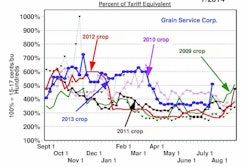As water becomes scarcer, the ability of Western states’ water policies to accurately reflect public interest, or adapt to changing public interests, will be tested. The current demand for water to support the oil and gas boom provides an example of this challenge.
Many western states’ water rights regimes are based wholly or in part on the prior appropriation doctrine—“first in time, first in right.” Some prior appropriation states approach water rights from an essentially value-neutral perspective; the purpose of the water appropriation is not analyzed further after the regulatory agency determines that the appropriation is for a legal, beneficial use. Other prior appropriation states require further analysis of the societal value of the water’s use. This public interest analysis can impact on water use and development across the state across all economic sectors.
Although the vast majority of consumptive use water in states like North Dakota and Colorado is currently used for agriculture and irrigation, the resurgence of the oil and gas industry is pressuring water supply. While historic agricultural water users generally hold protected senior water rights, the influx of new demand competes with agribusiness that is looking for new water rights to expand operations. Also, in states where water use is value neutral, the new demand can provide an opportunity for senior water users to capitalize on the value of their senior rights.
Of the sixteen Western States that require state regulatory agencies to perform some kind of public interest review prior to granting a water right, only a few of these—including North Dakota—specifically list public interest criteria that the regulatory body must consider. Other states like Colorado leave the term “public interest” undefined. While a listing of public interest criteria can provide stability and predictability for state water rights holders, leaving the term undefined can provide some flexibility in the face of changing state economic priorities.
North Dakota provides an example of a prior appropriation state with a detailed public interest analysis requirement for new water appropriations and water transfers. North Dakota not only defines the public interest factors that must be reviewed for a new water right to be granted, see N.D. Cent. Code § 61-04-06(4), but also it establishes a regulatory hierarchy of types of water use, N.D. Cent. Code § 61-04-06.1. While the earliest application for a new water right is generally considered first, if there are competing applications from the same source of water for different uses filed within 90 days of each other, a public interest analysis is performed and a specified order of priority is followed. In these instances, permits will first go to domestic uses, then municipal, then livestock, then irrigation, then industrial, and then fish, wildlife or recreation uses. N.D. Cent. Code § 61-04-06.1. Similarly, transfers of water rights are allowed if no other appropriation is injured, but the water use may only be changed to a superior use in the hierarchy. N.D. Cent. Code § 61-04-16.1 North Dakota statute also exhibits a strong disfavor against transferring groundwater rights away from irrigation uses. N.D. Cent. Code § 61-01-01.2.
By contrast, a state like Colorado does not recognize a hierarchy of uses. A water user must put water to a beneficial use in order to obtain a water right, but after a beneficial use is determined, the rest of the analysis is around water availability. Colo. Rev. Stat. § 37-92-302(1). There is no analogous “competition” between different water uses with respect to applications filed closely in time. Similarly, a water right may be changed to any other beneficial use. Colo. Rev. Stat. § 37-92-302(2)(a). Theoretically, this allows for market-driven water allocation, where a junior user with sufficient capital can acquire a senior water right and change the use to meet its needs. On the other hand, speaking generally, this regime can potentially destabilize particular water uses if it becomes more financially reasonable to sell a very senior water right rather than remain in business to use the right.
Water policies that purport to delineate a state’s public interest need to be flexible enough to adapt to long-term changes in those interests. Policy-neutral statutory regimes like Colorado’s may be more suitable to this need. However, even states with more rigid statutory public interest requirements can find ways to meet short-term demands. For example, North Dakota issued a policy in 2011 that would allow temporary transfers (no longer than one year) of irrigation rights to oil and gas uses. This allows short-term distribution of water to the oil industry, but does not confer a water right. Although this is not a long-term solution, it may redistribute the resource sufficiently in the short term to meet the current public interest without effecting traditional public interest in the long term.


















